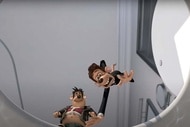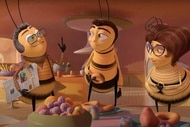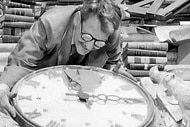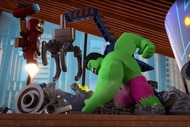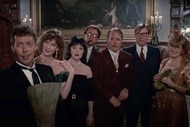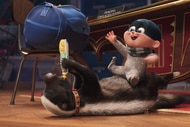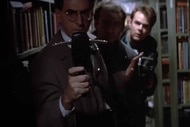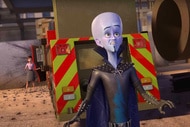Create a free profile to get unlimited access to exclusive videos, sweepstakes, and more!
How Sonic the Hedgehog and SEGA sparked the UK's Grime music scene

British music producer Joker, aka Liam McLean, listens to the classic Genesis Sonic the Hedgehog soundtracks at least once a year. The Genesis (called the Mega Drive in the UK) music whisks him back to his childhood where he spent hours playing the game when he was as young as 5.
"The Mega Drive was literally the beginning of my life and some of my first memories," he tells SYFY WIRE. "The house I had the Mega Drive in was the house I have all my first memories from. It was part of my first memories and the only music I listened to was on the games then."
The 31-year-old UK musician started out in a grime crew as a teenager and released a Sega mini-album called Joker Drive. To this day, he's still influenced by the 2D Sega platform game he started playing when he had just begun school.
Joker's not the only grime artist to be influenced by the distinctive tinny sounds found in Sega's '90s games about a blue hedgehog who likes to go fast, either. Grime is a very urban music genre, which started in the early noughties and is mainly based in London. It's influenced by a range of dance genres, as well as hip hop, and was an offshoot of the UK garage scene, which itself was another blend of dance genres, such as Jungle, which emerged from the UK rave scene. But what garage pioneered was the role of the MC or DJ who did not put on a "fake" American accent.
Grime continued that trend and the UK saw an urban movement in which young people told the world about their lives in their true voices. This was not a rip-off or homage to the U.S. hip hop scene but a sound that was distinct and eventually gained mainstream acclaim from the work of acts such as Stormzy and Wiley.
"Grime is the perfect amalgamation of UK dance and soundsystem culture," Brixton, London-based grime producer Sirpixalot says. He had a Mega Drive, as well, and particularly enjoyed the likes of Sonic 2. The games, he says, definitely informed his music.
"It's come out of UK garage but you have influence from dancehall [played by Jamaican soundsystems], even breakbeat, drum n bass (especially the crazy bass sounds) and computer games are a big influence on grime as well," he explains.
Grime started as a very home-based, DIY pursuit; acts would play around with synthesizers and create music using software, such as FruityLoops, and the same kids that used a Korg Triton — the millennium workstation favored by grime super-producers — would also have had a Mega Drive.
Sirpixalot and Joker both say many kids withdrew from the streets after the noughties, mainly because of their parents' fear of crime — in part due to the media's negative portrayal of teenagers, particularly black teenagers. As a result, many youngsters were given 16-bit consoles by their parents as hand-me-downs; the dad would have a new PlayStation in the lounge while the old Sega went into his son's bedroom.
"Sonic is 2D so it's much easier for kids to get a handle on it," artist and developer Dylan Beale explains. Beale created the soundtracks for a huge range of old-school titles for Bits Studios and now works as a development director for Wargaming. Sirpixalot reckons Beale created the first-ever 'grime' instrumental on the Super Nintendo (SNES) game Wolverine in 1994.
"So their earliest memories will be 2D platform games," he continues. "Sonic was a classic and appeals to my four-year-old son who loves stuff like that. He can recognize Sonic in a heartbeat."
The Wolverine track Beale created is a great example of how music on consoles in the '90s sounded "grimey," especially the end-of-level boss soundtrack.
"We were given the SNES version and about £250k [for the entire game and music] to make it in six months," he says, and then explains that nowadays games have a lot longer lead times and bigger budgets.
"We set ourselves a challenge: could we write an entire soundtrack, get all the sound effects and voice over and squeeze it into 200K of memory?" he says. "So when I wrote that music the primary goal was to write something hip hop for the main levels and really ramp it up and be influenced by the UK hardcore scene in the boss levels."
Hardcore had thicker, harsher bass lines than other UK dance music in the mid-'90s. Joker describes the sound as "screw face," a dark sound that is particularly synonymous with a lot of grime tracks — including this 2011 track from Lethal Bizzle (below).
"I mean you're not going to get to the boss and it be the happiest song in the world," he explains, laughing. The sonic and technical restrictions of old consoles meant that in the '90s, Beale produced "futuristic" music that now sounds similar to a lot of grime tracks. Both possess the same grungy, raw, DIY feel.
Joker and Sirpixalot even go on to lament that nowadays game music is different; when you play games such as Call of Duty, it feels more orchestral and movie-like. It's a far cry from the '90s when people's first exposure to a new genre of music often came from playing a video game.
Now the release of a Sonic film adaptation starring James Marsden and Jim Carrey could inspire a whole new generation of kids to check out a '90s platform game that inspired so many British musicians. In fact, it feels like Joker only agreed to do this interview because of his love of the game.
In his case, Sonic will always be a subject that he speaks passionately about. So much so that he even half-seriously reveals aspirations to revive Sega's most iconic gaming series.
"I know how to make the perfect Sonic game. I'm not going to say, though!"

